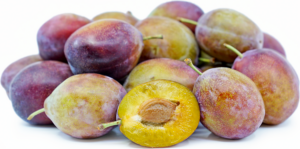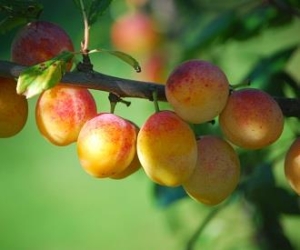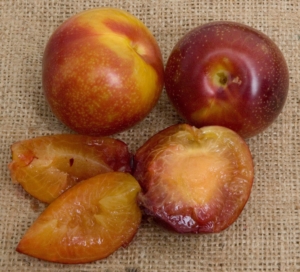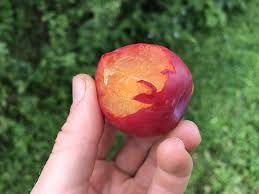Plums for 2025
*European and Asian plums are different species and will not pollinate each other.*
ALL our plums are on Marianna 2624 Semidwarf rootstock unless otherwise noted.
European Plums (Prunus domestica vars.)
Blue Damson: Not only does this heirloom variety yield oblong, purple-skinned fruits with yellow-green flesh and a sweet tart flavor that is great for fresh eating and especially cooking, but the tree in bloom is a lovely sight in the spring! Self-fertile, but will be more productive when paired with a different European plum variety as a pollinizer. Citation rootstock.
Green Gage: Many say a Gage plum has the best flavor of all plums. Gage plums are small, rounded, and yellow-green. They are juicy and firm with a sweet, melt-in-your-mouth flavor. Excellent fresh, or for baking, preserves and canning. Self-fertile, but may produce better with a different European plum pollinizer. Ripens in late August.
Imperial Epineuse: Considered one of the most delicious plums you can grow, this plum has grown famous for its sweet, flavorful fruit. This French variety has a reddish-purple skin and yellow flesh. Large fruits are excellent for either fresh eating or drying. Once mature, the tree is a heavy producer, often yielding over 50lbs of fruit in a season. Self-fertile but may produce better with a different European plum pollinizer. A WSU Mt. Vernon recommended variety.

Early Italian Prune: Very similar to Italian prune plum but ripens a few weeks earlier. Citation rootstock.
Italian Prune: Perhaps the most widely planted and beloved fruit tree in history. Deep purple oblong freestone fruits with tasty yellow flesh are great fresh off the tree and are especially suited for drying, canning and cooking. Flesh turns a nice red color when cooked. Ripens in August. Self-fertile. Can take a few years to start producing. A WSU Mt Vernon recommended variety.
Mirabelle de Metz: Hailing from France, these beautiful freestone plums are small and yellow dotted with carmine red. This very old, French cultivar is exquisitely-flavored, ripens in late summer and produces heavily each year. The intensely sweet and fragrant fruits require very little added sugar to create luscious preserves and baked goods. Needs another European plum pollinizing partner. Upright and blazingly productive most years.

Asian Plums (Prunus salicina vars.)
Beauty: This variety is well suited to the cool summers of western Washington. The fruits have red and yellow skin with amber-red flesh. Some say this is the most flavorful Japanese plum, sweet and juicy with a delicious flavor that melts in your mouth. Excellent for fresh eating. Vigorous and productive. Ripens in early August. A good pollinizer for many other Asian plum varieties, it is considered self-fertile but will produce more heavily with another Asian plum nearby. A WSU Mt. Vernon recommended variety.

Methley: Medium to large clingstone fruit with juicy red flesh and red/purple skin. Great for fresh eating and for jelly. Flowers early with white blossoms. Ripens in early summer. Produces at a young age and sets a reliably heavy crop. Self-fertile, but best with another variety of Asian plum as a pollinizer.
Toka: One of the hardiest Asian plum varieties. This Asian x American plum hybrid has small-to-medium size red fruit with yellow flesh that ripens in August and is so sweet, spicy, and fragrant it is commonly called the Candy or Bubblegum plum. The vigorous, upright tree is covered with white blossoms in early spring, bushels of fruit in the summer, and beautiful red fall foliage. Self-fertile and is an excellent pollinizer for other Asian and hybrid plums.

Plum Rootstock
Marianna 2624: Shallow root system tolerant of wet soils. Resists oak-root fungus and rot knot nematodes. Mature trees on this rootstock typically attain 15-20 feet but can be maintained at a desired height by summer pruning.
